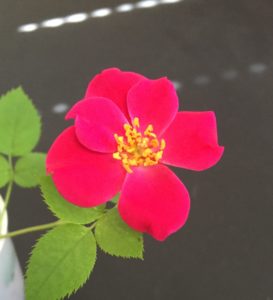July Pruning and Rosy-Related Ramblings 2
Views: 540

Today’s blog is part two of two on pruning roses (and other rosy-related ramblings). It will concentrate on the pruning of repeat blooming (or remontant) roses. My last blog concentrated on the pruning of once blooming roses (and other rosy-related ramblings).
Another quick note about hybridizing
As I have stated in my last blog, hybridizing and creating new roses is the part of the rose-growing hobby that piques my interest the most. When I get new roses, I almost always check them for seed set and subsequent seed germination. For those who wish to explore creating new roses and testing their roses, the time to start thinking of this is now – before you prune your roses and remove the hips. More information will follow regarding the planting of the seeds in a future blog. Additional information about creating your very own hybrid roses can be found at rosebreeders.org. Please be sure to do any research on creating your own roses now before starting to prune your roses.
About remontancy and remontant roses
Remontant roses are roses that repeat bloom or bloom more than once in a season. They send out new canes and blooms appear at the ends of the canes. Once the blooms fade and are done, these same canes send out additional canes. These canes will have a blooms on them as well. This is happens in the same season without a dormant winter period between bloom cycles. Most modern roses are repeat blooming.
The ability to repeat bloom is one of the rose’s most exciting and enduring qualities. This is one of the rose’s main attractions and why they are so popular. I adore the great blast(s) of color that often accompany once blooming roses. However, I admit that if my garden was devoid of repeat blooming roses, I probably would have given up growing roses and gravitated back to one of my other hobbies.
History
The ability for roses to repeat bloom comes from complex hybridization and various mutations that were exploited many, many years ago. This was accomplished largely by roses from Asia and the Far East that are naturally remontant. In a general sense regarding the history of the rose, roses that originated from Europe were once blooming, and those originating from Asia, China and the Far East were remontant (as well as many once blooming roses). There were some exceptions to this. But, generally speaking, the roses from the Far East were largely responsible for remontancy enjoyed in the genus rosa. It wasn’t until these remontant roses made their way to Europe that the hybridizers of long ago were able to exploit these repeat blooming genes and combine them with the European ones.
When it comes to pruning repeat blooming roses, one has to realize that repeat blooming roses never go totally dormant. Even in the coldest of winters, remontant roses will still grow, but very, very slowly. This is a blessing as well as a curse, because during the warmer days of January, February, and March remontant roses send signals that it’s time to grow, only to have the colder temperatures return and destroy the newly formed, tender growth. Roses grown in areas that never freeze (such as Florida, California, etc.) bloom continuously all year.
Pruning repeat blooming roses
Take out dead, diseased, or damaged canes whenever you see them. Removing these canes is the first step in pruning your roses and started on another bloom cycle. By the book, the basic technique for pruning roses is as follows: after the blooms have faded and done, go down the cane to the first outward facing five leaf axil and cut the cane at an angle ¼” above the budeye. Remove any spindly canes not larger than a pencil and the weaker of any two crossing canes. Open the center of the rose to improve air circulation and to allow sunlight to penetrate.
Things to remember
While true and correct, it should be noted that not all roses have five-leaf axils. You would need to adapt this rule for those roses that do not develop five leaves. On most full-sized roses, I cut down to the first set of leaves with an outward facing budeye that is the width of a pencil (or bigger). I cut the cane at an angle ¼” above the budeye. I then remove any additional “spindly” canes smaller than a pencil and the weaker of any two canes that are crossing. (Be aware that no cane can support another cane larger than itself). The center of the rose is then opened up to improve air circulation as well as to allow sunlight to penetrate. I then take a step back and shape the rose as desired to fill the area allotted to it.
On miniature and miniflora (and some other large) roses, it should be noted that they often do not have canes that are larger than a pencil. If one were to cut all of the canes down to the diameter of a pencil, most of the plant would be cut away. For these types of roses, I usually count down two or three leaflet sets to the first outward-facing budeye and prune ¼” above it. I follow through by removing the very tiny canes that will never be able to support a worthwhile bloom. I later remove the weaker of two crossing canes. Then I shape the rose to the space allotted to it and as desired.
A few additional notes about pruning
It also should be noted that when the basic rule is followed religiously to cut to every first five leaf axil, a rose bush may be created in due course that is “leggy,” and not necessarily a pleasing plant to look at. When roses become leggy, they often have canes that are bare and devoid of leaves at the bottom. Often times they appear “woody.” As one looks further up the canes on leggy roses, one may notice that there are multiple stems growing on stems with the tops of the plants having leaves with smaller blooms. This creates a rose that looks “top heavy.” This is sometimes what happens after one plants a new rose and likes the way it grows when they first receive it, but in time as the plant matures, becomes leggy (and top heavy) they don’t like how it looks.
Roses are what you want them to be
If having roses that are leggy and top heavy is the effect that you desire, fine, prune away at all of the first five leaf axils and create roses that are to your liking. I’m not going to lecture you about doing it incorrectly. There are no rules as to how you want your rose garden to look, and who am I to criticize it? You only have to please yourself (and probably your spouse). But, I prefer roses that are shorter, not so leggy, and are not bare on the bottom. I also prefer to shape my plants the way I want them, how I think that they look best in my garden, and not necessarily the way the roses want to grow on their own.
Also, be aware that pruning roses is an art form, and most rosarians prune differently based on the garden that the roses are growing in, their own personal likes and dislikes on how the roses should look, and not by the book. I also prefer that my plants send out as many basal canes as possible to help the plant rejuvenate themselves throughout the season. We sometimes call this keeping the roses “young.” You accomplish this by not allowing roses to become leggy as they mature. The energy that normally goes upwards to the higher canes is forced into new basal breaks.
Know your roses
When pruning roses it is important to know your roses and how they grow. Do not assume that the descriptions listed in brochures and on websites will be how they actually grow. Many factors are part of how a rose grows (or doesn’t grow). Among these are the cold hardiness zone you live in, or the heat zone you live in, or the amount of sunlight per day the rose receives, as well as many other factors. It should be noted that there is more and more overlap between the classes of modern roses. What is considered to be a miniature rose now, can be nearly identical to that of what we used to be considered a miniflora (or a floribunda).
Research is key to having a successful rose garden in today’s day and age. There are many resources available to help you. One of your most important resources is the American Rose Society and their many local consulting rosarians. Be sure to ask them all of your questions. Their job is to answer them for you.
A new baby rose almost lost
I welcomed a new baby rose a few weeks ago. She is an amazing color of red. I found the seed that she came from in my garage weeks after I planted all of the other seeds. When I found her she had germinated and needed a place to spread her roots right away. It took a little doing, but I was able to get her hydrated and started on her way to being one of my newest baby hybrids. We’ll see where she goes from here, but she is my little miracle rose that was on the brink of extinction that is now on its way to true rose beauty.
Until next time. Stay cool. Be sure to remain well hydrated in these everchanging hotter climates we find ourselves in.
Epilogue
This story was originally composed with a modern Shaeffer fountain pen that was lost for a few months. When I found it, I was looking for a good flowing pen to compose this story. Even though the pen was among the missing for quite a while, the ink was ready to go. What a great feeling to have a pen at the ready. (It writes smooth as silk too).
Meet Andy Vanable
Andy's Recent Posts

The Rose-Growing World Loses an Icon – Bob Martin






